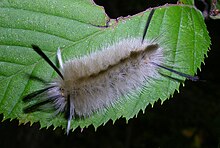Banded Tussock Moth
Halysidota tessellarisSummary 6
Halysidota tessellaris, the banded tussock moth, tessellated halisidota, or pale tiger moth, is a moth in the family Arctiidae. Like most species in this family, it has chemical defenses it acquires from its host plants, in this case, alkaloids (Weller et al., 1999, Hristov and Conner 2005), at least in the adult. The brazen behaviour of the larvae also suggests chemical protection in this stage, although they have not been analyzed for alkaloid content.
Halysidota tessellaris 7
Range[edit]
This moth is found from southern Canada, and south to Texas and central Florida in North America (Wagner 2005).
Life cycle[edit]
One generation per year occurs in the north, and two or more in the south (Wagner 2005).
Egg[edit]
Eggs are laid in masses on the undersides of leaves (Rose and Lindquist, 1982).
Larva[edit]
Caterpillars are covered all over in long, hairlike setae, in tufts. These vary in colour from yellowish and orange to dark gray. Extra long 'hair pencils' of white, black, and/or orange occur at both the front and rear of the caterpillar. The head capsule is bright orange. In the north, mature caterpillars are found from July to frost (Wagner 2005). Caterpillars frequently rest on the upper surface of leaves, and though not gregarious, are very conspicuous (Wagner 2005). They grow to a length of 35 mm.
Pupa[edit]
The gray cocoon is laced with 'hairs' from the larvae, and overwinters (Wagner, 2005).
Adults[edit]
The wings are yellowish-white. The forewings have bands of beige edged in faint black across them. The body is 'hairy' and yellow. The thorax has blue-green lines on the upper sides. Adults are attracted to decaying plants that have pyrrolizidine alkaloids (Krasnof and Dussourd, 1989). They regurgitate on them, then drink the fluids to acquire these defensive chemicals.
Food plants[edit]
Larvae are known to feed on alder, ash, birch, blueberry, chestnut, elm, grape, hackberry, hazel, oak, walnut, willow, and many others (Wagner, 2005). No serious injury to trees has been reported for this late-season feeder (Rose and Lindquist, 1982).
References[edit]
- ^Hodges, R.W (1983). "Halysidota tessellaris". NatureServe. Retrieved 18 July 2013.
- Krasnoff SB, and DE Dussourd, (1989) Dihydropyrrolizine attractants for arctiid moths that visit plants containing pyrrolizidine alkaloids. Journal of Chemical Ecology 15: 47-60.
- Hristov, NL, and WE Conner, 2005. Effectiveness of tiger moth (Lepidoptera, Arctiidae) chemical defenses against an insectivorous bat (Eptesicus fuscus). Chemoecology 15(2):105-113.
- Rose, AH and OH Lindquist (1982). Insects of eastern hardwood trees. Canadian Forestry service, Forestry Tech Rep 29. Government of Canada, Ottawa. ISBN 0-660-11205-1.
- Wagner, DL, (2005) Caterpillars of Eastern North America. Princeton University Press.
- Weller SJ, Jacobsen NL, Conner WE (1999) The evolution of chemical defenses and mating systems in tiger moths (Lepidoptera: Arctiidae). Biol J Linn Soc 68:557–578
Sources and Credits
- (c) David Yeany, some rights reserved (CC BY-NC), uploaded by David Yeany
- (c) Susan Elliott, some rights reserved (CC BY-NC), uploaded by Susan Elliott
- (c) Fluff Berger, some rights reserved (CC BY-SA), uploaded by Fluff Berger
- (c) kalacaw, some rights reserved (CC BY-NC-SA), http://farm3.static.flickr.com/2656/3906190307_43f11e00bb.jpg
- (c) Cody Hough, some rights reserved (CC BY-NC-SA), http://farm4.static.flickr.com/3004/2896325195_bbc6139dd4.jpg
- (c) Wikipedia, some rights reserved (CC BY-SA), http://en.wikipedia.org/wiki/Halysidota_tessellaris
- (c) Unknown, some rights reserved (CC BY-SA), http://eol.org/data_objects/31668796
More Info
- iNat taxon page
- Animal Diversity Web
- Biodiversity Heritage Library
- BOLD Systems BIN search
- BugGuide
- Butterflies and Moths of North America
- CalPhotos
- CUIC Insect Images
- Global Biodiversity Information Facility (GBIF)
- HOSTS - a Database of the World's Lepidopteran Hostplants
- Maryland Biodiversity Project
- Maryland Moths
- Mass Moths
- Moth Photographers Group
- Moths of North Carolina
- NatureServe Explorer 2.0
- Pacific Northwest Moths












